A private, invite-only meeting of Central Eastside power-brokers held on Wednesday at the Oregon Museum of Science and Industry shows just how seriously the City of Portland is taking an effort to establish a network of low-stress, “family-friendly” cycling routes throughout the Central City.
It also shows how much weight some business owners have in a planning process that’s over five years old and has yet to become open to the general public.
Before I bring you up to speed on the Central City in Motion project (formerly known as the Central City Multimodal Project), a bit of background is in order…
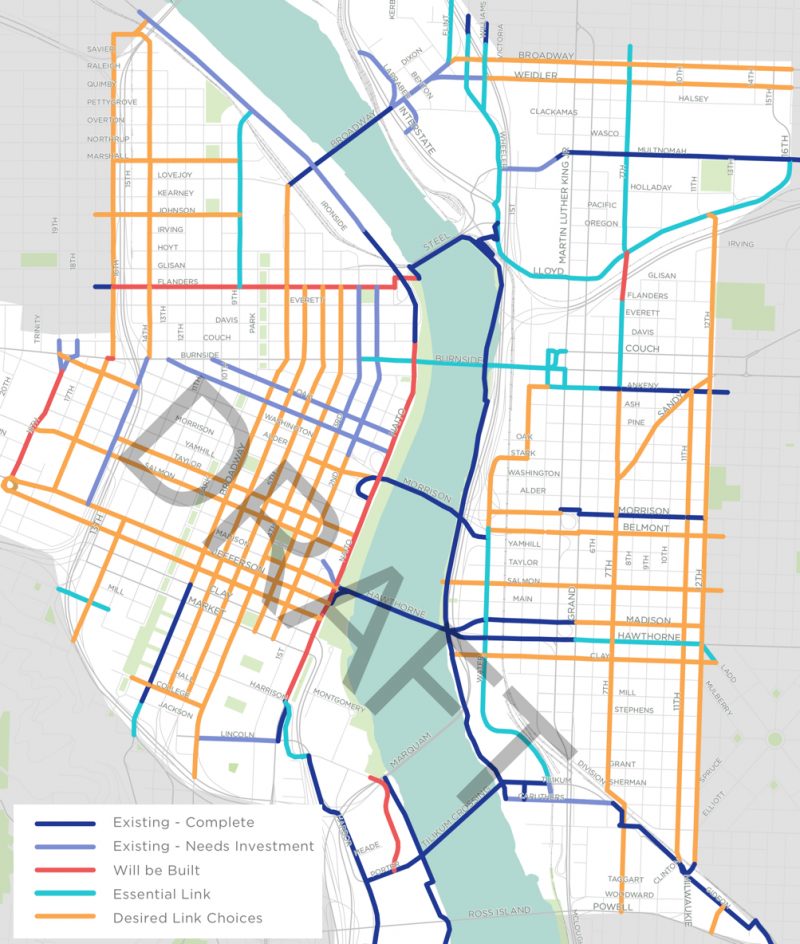
Orange lines are streets under consideration by PBOT to become part of the new “family friendly” network.
PBOT has taken a very slow road on this project. It’s been on their radar (and ours) since late 2012 and they still haven’t held a single public open house. Portland City Council voted to support the federal grant for this work in September 2013. Nearly a year later, and with not a peep from PBOT about it, The Street Trust tried to create some urgency. PBOT said they were waiting for federal funds to materialize.
By January 2015 the City was still seeking a project manager to get the planning started. By May they’d found one. With a project manager in hand, PBOT planners and downtown business leaders traveled to Copenhagen for a week-long study tour to prime the pump for future Portland projects. Seven months after they returned, in February 2016, the man hired to manage the project for PBOT says he was fired.
“A network that’s connected and coherent and designed for safety that can get kids and families and Central Eastside employees where they need to go around the district. It won’t be every street, but there will be a network and we’ll have it well-signed so you know how to get to the bridge to to downtown.”
— Katie Mangle, Alta Planning + Design
By May 2016 PBOT finally announced what appeared to be real progress. Buoyed by additional funds from the local gas tax, the City’s new project manager Gabe Graff said the $8.4 million plan would, “fill in a more comfortable and protected bicycling network.” Along with an explanation of why the project had taken so long to materialize, PBOT spokesman John Brady told us at the time that public outreach and planning would start that summer.
That didn’t happen.
The project was formally adopted by City Council in August 2016. At that time (which is the last we reported on this project) were told public outreach would begin shortly thereafter, 2017 would be spent on planning and design, and construction would begin in 2018.
That didn’t happen either.
Instead, PBOT has spent 18 months seeking feedback on the project from neighborhood groups, business organizations and city committees. Their website lists 20 presentations or meetings between June 2016 and May 2017. Of those, eight were held with groups that represent business owners including the Portland Business Alliance (who they’ve met with three times), the Central Eastside Industrial Council (CEIC), the Downtown Retail Council, and Business for a Better Portland.
In April 2017 PBOT held a design charrette focused specifically on the Central Eastside Industrial District (CEID). 17 stakeholders attended, as well as 11 PBOT staff and eight consultants from three private companies that have contracts to help with the planning.
In November of last year PBOT formed an 18-member Sounding Board charged with, “‘thinking big’ about the future of transportation in Portland’s central city,” and representing, “a broad set of community and business perspectives.” They’ve met twice since then. This Sounding Board is in addition to the 13-member Technical Advisory Committee that’s met twice since October.
All of these meetings have happened before the City has made any formal public outreach or received any feedback from the general public.
In December of last year PBOT released the result of all this input: A map showing Portland’s Central City “low-stress network” and the “desired link choices” they want to establish through this project. When you look at that map, you’ll notice a glaring lack of north-south routes through the Central Eastside.
That’s what brings me back to the meeting on Wednesday. It was a follow-up to that design charrette back in April.
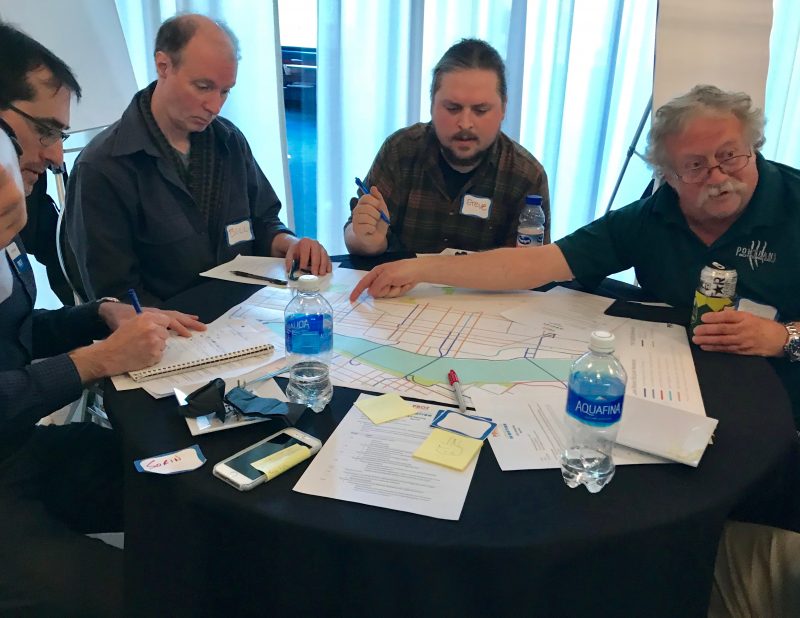
Left to right: Scott Cohen, PBOT; Bill Stites of Stites Design; Steve Bozzone, Bozz Media; Tom Keenan, Portland Bottling Co.
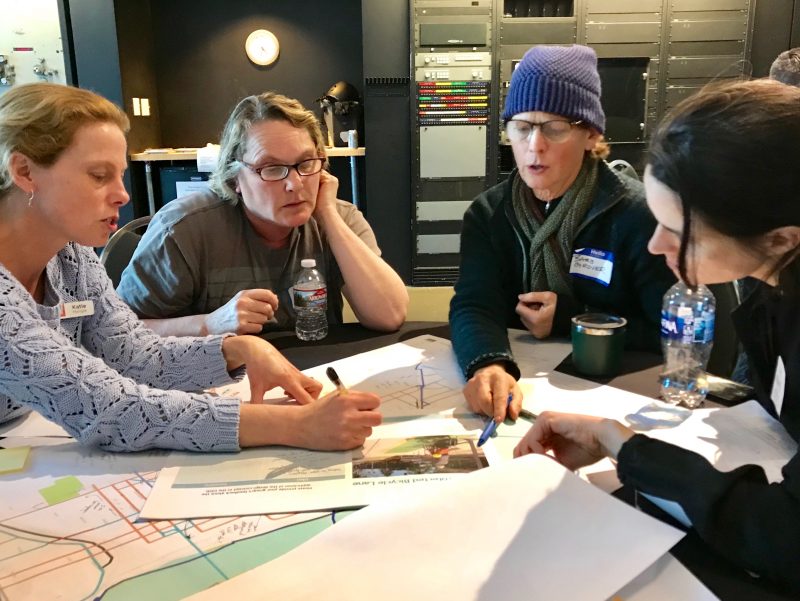
Alta Planning + Design consultant Katie Mangle (left) and Splendid Cycles co-owner Barb Grover (hat).
The Central Eastside — roughly defined as the area bordered by OMSI, the Willamette River, 12th Avenue and NE Multnomah (or so) — is a big target for PBOT. They understand it’s imperative that we create safer, more bikable, and human-scale streets in this area — but they also understand there are many entrenched interests that are wary of anything that will constrain freight or auto parking capacity. The heart of the CEID is a heavily industrial area that’s changing rapidly from freight-centric to office and residential uses. While this transition happens, the safety of mixing walkers and bicycle riders with large trucks also looms over these discussions.
PBOT phrases their careful approach here as, “preserving the industrial character of the CEID.” But the tension among the staff, advocates, consultants and business owners in the room is about compromise. Who will have to give up what in order for the goals of the project to be reached?
At Wednesday’s meeting I heard an unexpectedly productive conversation. With CEIC bigwigs like Beam Development President Brad Maslin, New Seasons Market Director of Real Estate Lisa Lamanna, Portland Bottling Company VP Tom Keenan, and Franz Bakery Fleet Manager Mike Albrecht on hand, PBOT project manager Gabe Graff and Katie Mangle with Alta Planning steered breakout groups into a discussion that zeroed in on the specific streets where changes should be focused.
Also in the room were Central Eastside business owners like Barb Grover of Splendid Cycles, Charlie Wicker of Trailhead Coffee Roasters, Biketown General Manager Dorothy Mitchell, Clever Cycle Co-owner Eva Frazier, and others.
At the outset, Graff said PBOT’s goal is to “provide low-stress bikeways, prioritize tranit, and increase pedestrian safety in our central city.” “It’s a unique project for us,” he continued, “In that we have funding for the planning phase and to figure out where these projects should go — we hope to have that wrapped up by this summer — then we’ll have funding on the backend to deliver on those projects. So we can turn around immediately from these kind of planning exercises and go into design and construction.”
While there weren’t any votes or hard lines put on a map Wednesday, some themes emerged.
Former CEIC President and current member Peter Stark thinks it’s time to talk about the Martin Luther King Jr. Blvd and Grand Avenue couplet. “We currently have a misuse of the roadway. King/Grand shouldn’t be a drive-through for our district,” he said during one of the breakout sessions. “We need improvements to make that a safer place for people to shop, work and live.” Stark wasn’t the only one making the case for taming the MLK/Grand couplet. If the CEIC is to ever become a great place to walk and bike, the thinking goes, MLK/Grand must be addressed.
The future of 7th Avenue is likely going to be a big part of this debate. It’s the most direct and well-known north-south route in the Central Eastside — but freight interests can’t envision it as ever being a “family-friendly bikeway.” There was a lot of talk on Wednesday about how 7th compares and contrasts with 6th Avenue. Both of these streets have also been set aside as part of the possible future alignment of the Green Loop, which gives them added priority in PBOT’s planning hierarchy.
While 6th might be lower-traffic and easier to foresee (for some) as a “low-stress” route, it doesn’t connect as well to the existing system. 7th has also been chosen as the alignment for the forthcoming Sullivan’s Crossing Bridge.
Right now PBOT’s CCIM map doesn’t have any “desired link choices” between 7th and Water Ave. That’s seven blocks without a good bike north-south bike route. One possibility is to create an “industrial greenway” on 3rd; but as you can see in the map below, 3rd has intense freight usage.
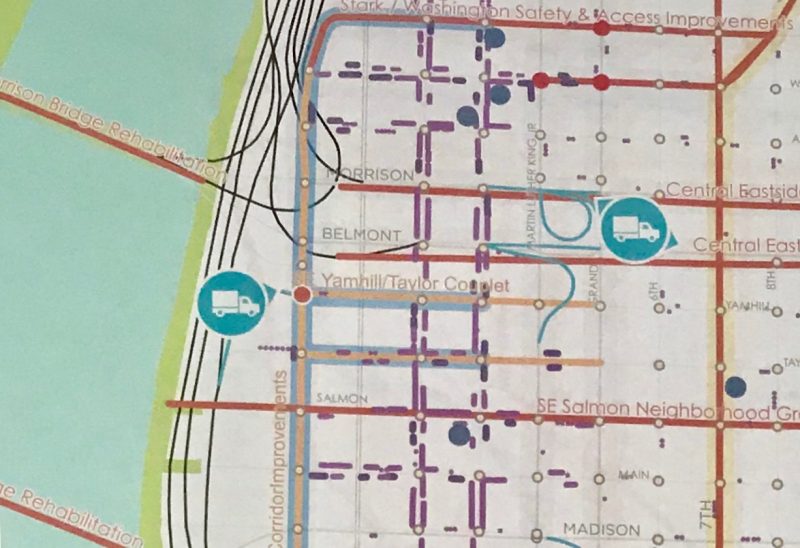
PBOT/Alta map showing Central Eastside Industrial District. The blue dots are “freight generators,” the purple lines are loading bays/docks.
Regardless of which north-south streets get chosen, one Central Eastside Business owner, Steve Bozzone of Bozz Media, expressed concerns that PBOT is missing the key connections. Bozzone lives in north Portland and enters the District via the Oregon Convention Center. “We already missed an opportunity when Streetcar took a lane on MLK,” he said in a group discussion. He wants the project to improve access between the Convention Center and 3rd.
“We have bike lanes on many of the streets. What if we were to remove those and consolidate them on one or two blocks and make those streets dedicated for bikes?”
— Brad Maslin, Beam Development/CEIC
Water Avenue came up a lot on Wednesday. There was talk of making a two-way cycle-track on Water to relieve pressure on the Eastbank Esplanade (which several people said was anything but “low-stress” due to how “fast those bicyclists ride”). Water’s connection to the Hawthorne and Morrison Bridges make it a lynchpin in this plan and it’s safe to assume it’s not a matter of if it’s improved but how.
One cool idea I’d never heard of before: Connect Water Avenue directly to the Esplanade with a new path at SE Stark via an existing access road currently owned by ODOT.
Another over-arching theme of this Central Eastside discussion is whether it’s smarter to create just a couple very good bike streets, or if PBOT should spread the funding around to make most of the streets bike-able. “Is there any common sense to aggregating bike lanes,” Brad Maslin with Beam Development wondered out loud. “We have bike lanes on many of the streets. What if we were to remove those and consolidate them on one or two blocks and make those streets dedicated for bikes?”
That type of thinking could carry weight, given that PBOT has set a high bar for the type of conditions they want to create. Even project consultant Katie Mangle with Alta Planning + Design repeatedly said they can’t improve every street. “We’re looking for the minimum network we can do,” she said, “Because we want this to be something we can build in the next five years.”
By then, she added, we’ll have “A network that’s connected and coherent and designed for safety that can get kids and families and Central Eastside employees where they need to go around the district. It won’t be every street, but there will be a network and we’ll have it well-signed so you know how to get to the bridge to to downtown.”
That’s a very appealing vision. The question remains though: Does PBOT have the courage to push for it? Even in the face of opposition from the CEIC? Maybe these two private design meetings have calmed the CEIC’s nerves. Time will tell. I did find it noteworthy however, that the final word on Wednesday came from CEIC Community Engagement Director Kate Merrill, who ended the meeting by saying, “One thing we must always keep in the back of our minds is that freight is the backbone of our district.”
To which Mike Albrecht from Franz Bakery replied under his breath, “I’ll get you that $20 later.” Then everyone laughed.
Whether or not everyone’s still smiling at the end of this road remains to be seen.
Learn more about the Central City In Motion project on PBOT’s website. And stay tuned for the online open house to go live on Monday.
— Jonathan Maus: (503) 706-8804, @jonathan_maus on Twitter and jonathan@bikeportland.org
Never miss a story. Sign-up for the daily BP Headlines email.
BikePortland needs your support.
The post Dispatch from a secret meeting for the Central City in Motion project appeared first on BikePortland.org.
from Latest headlines from BikePortland http://ift.tt/2phLypK
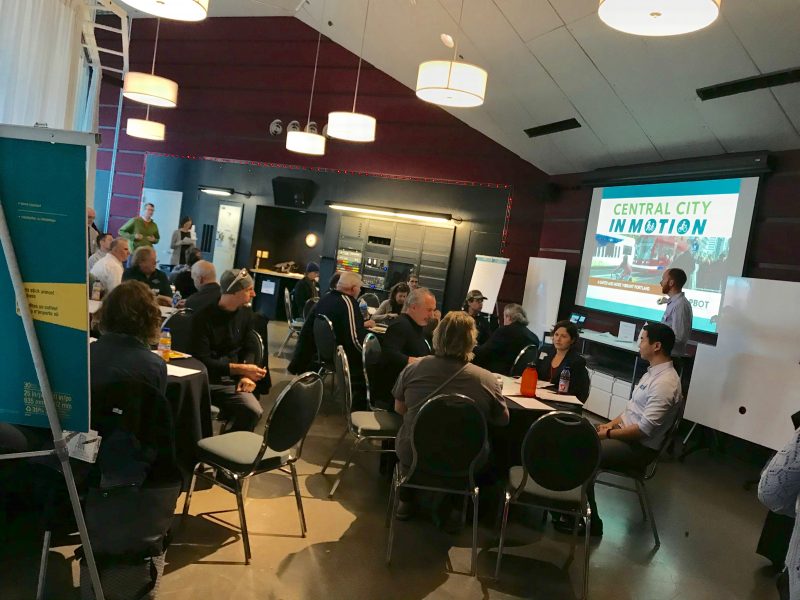
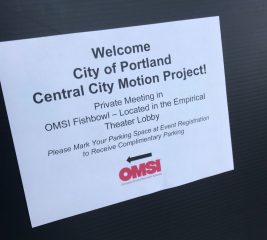
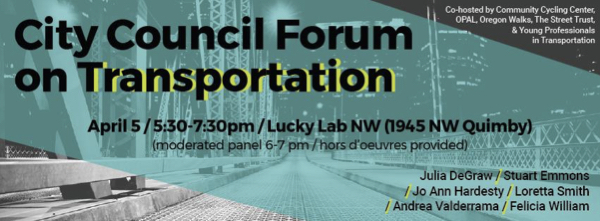
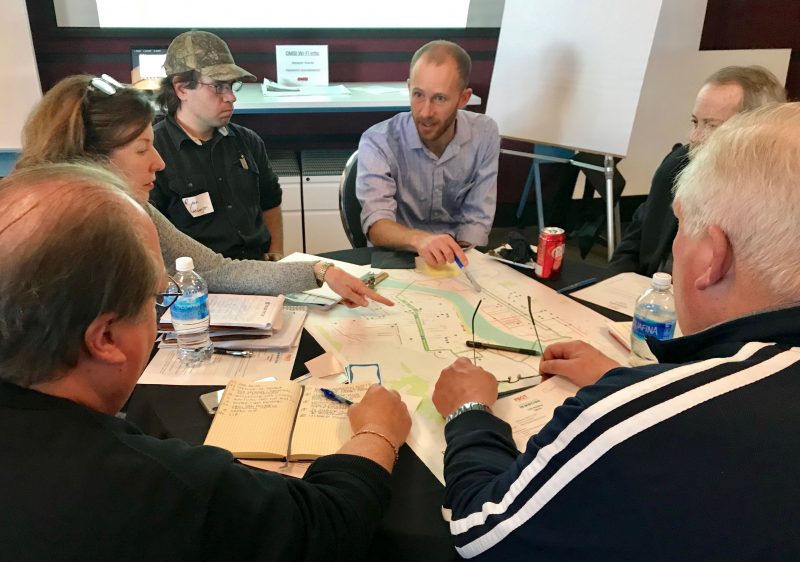
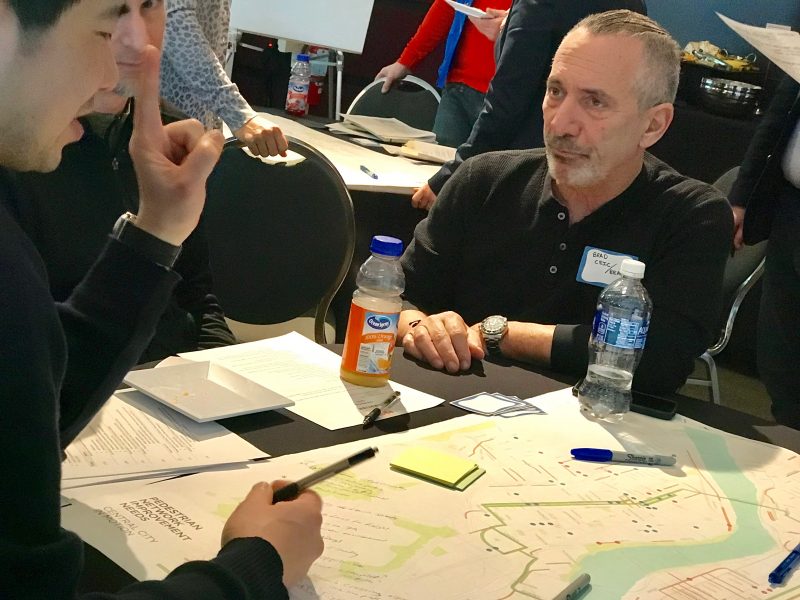
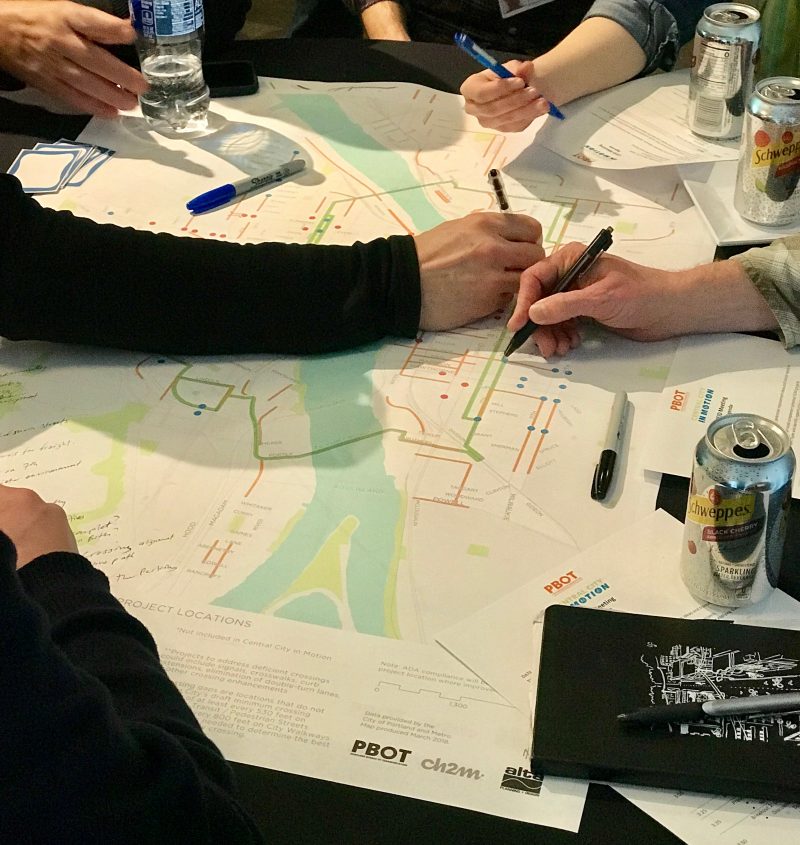
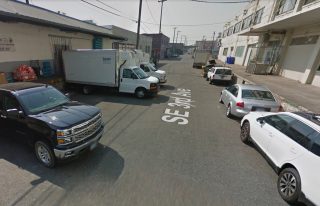

No comments:
Post a Comment